Notes: Although the Welsh spelling of the town is Caernarfon, some railway companies showed cavalier disregard for rendering Welsh names accurately, and the original form of the station’s name was Carnarvon, later adjusted to Caernarvon.
Caernarvon station was on the Menai Bridge – Afon Wen line which opened in stages between 1852 and 1871. The station was originally a terminus of the Bangor & Carnarvon Railway (B&CR) which was incorporated on 20 May 1851 to build a line from the Chester & Holyhead Railway (C&HR) at Menai Bridge to Caernarfon (‘Carnarvon’ at that time). The single track opened to Carnarvon for passenger services on 1 July 1852; goods services followed on 10 August 1852.
by that time, working trains on the C&HR; the C&HR had leased the B&CR. In 1853 there were four trains to and from Bangor on weekdays and two on Sundays. From 1 October 1854 mails were carried from Carnarvon. By August 1862 Carnarvon had seven weekday passenger trains to and from Bangor worked by Carnarvon-based engines and men; there were also three trains on Sundays.
On 29 July 1862 the Carnarvonshire Railway was incorporated with powers to build a railway from Carnarvon to Portmadoc. The line opened between Afon Wen and Pant, 1½ miles to the south of Carnarvon, on 2 September 1867 and was transferred to the LNWR in March 1869. In 1867 the B&CR was absorbed into the C&HR.
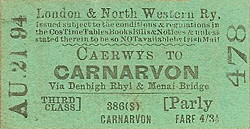 |
Another line opened from Llanberis to Carnarvon on 1 July 1869. It was built by the Carnarvon & Llanberis Railway and had a temporary terminus on the south side of Carnarvon. In July 1870 it became part of the LNWR. This gave Carnarvon three terminus stations all worked by the LNWR. As early as 5 July 1865 a link line had been authorised to connect all of the railways. |
Called the ‘Carnarvon Town Line’ it involved extending the Afon Wen line to meet the Llanberis line and the building of a 163yd tunnel under the town. This enabled the two lines that approached from the south to form an end-on junction with the B&CR just south of Carnarvon station. The line was first used by goods services in August 1870 and by passenger trains from January 1871; the through route from Menai Bridge to Afon wen had been completed.
Carnarvon then became a through station. Alterations were made in 1870 which included a lengthening of the platform and the creation of bay platforms at both ends. The original goods shed was demolished and a new one built on a different site in the yard. Stables for eight horses and store rooms for hay and harnesses were also provided. A new locomotive depot with a 42ft turntable was built.
In 1871 authorisation was given for the doubling of the original B&CR, and work was complete by 1872. By 1879 the C&HR had been formally absorbed into the LNWR although it had effectively been part of that company’s network for many years.
| In 1894 major alterations were made at Carnarvon station. A new island platform was built to the west of the original; its two platform faces were designated the local platform line, which was numbered 2, and ‘up’ (to Bangor) platform line numbered 1. On the platform a single-storey timber building with a canopy was provided, housing passenger facilities which included a |
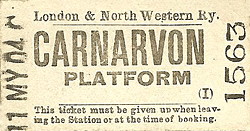 |
waiting room and toilets for both sexes.
The new platform was built on the site of the original signal box and part of the goods yard. The yard was extended to the west, and through goods lines were provided to the west of the island platform. An LNWR timber signal box with 68 levers called Carnarvon No. 1 opened to the north of the station. At the south end of the original platform, which had become the ‘up and down’ direction platform numbered 3, an LNWR brick base with timber upper cabin signal box with 51 levers - Carnarvon No. 2 - was also opened.
The original building was extended and provided with a new booking hall and office. A covered footbridge to the south of the station building linked the platforms.
In December 1895 Carnarvon had seventeen Monday to Friday departures as shown on the table below. On Sundays there were two trains to Bangor and one to Afon Wen.
| Up Departures (Northbound) December 1895 |
Destination |
Down Departures (Southbound) December 1895 |
Destination |
| 7.25am |
Manchester Exchange |
9.50am |
Afon Wen |
| 8.30am |
Bangor |
9.52am |
Llanberis |
| 10.05am |
Manchester Exchange |
12.40pm |
Afon Wen |
| 12.30pm |
Bangor |
12.42pm |
Llanberis |
| 3.05pm |
Bangor |
2.55pm |
Afon Wen |
| 3.45pm |
Bangor |
4.45pm |
Afon Wen |
| 6.30pm |
Bangor |
4.50pm |
Llanberis |
| 8.15pm |
Bangor |
6.45pm Saturdays Only |
Nantlle |
| |
|
8.01pm |
Afon Wen |
| |
|
8.05pm |
Llanberis |
In 1911 the future King Edward VIII had his Investiture as Price of Wales ceremony at Carnarvon. To cater for the event a temporary timber island platform was built in the goods yard. An additional bay, also of timber, was constructed at the north end of the station opposite the original one. Trains travelled from all over the Country to the investiture, although the royal party actually alighted at Griffith’s Crossing station, a few miles to the north, so that they could be part of a parade into the town.
In July 1922 there were sixteen northbound Monday to Friday departures and eighteen southbound, with extra workings on Saturdays, as shown in the table below; no Sunday service was shown.
| Up Departures (Northbound) July 1922 |
Destination |
Down Departures (Southbound) July 1922 |
Destination |
| 6.42am |
Bangor |
6.55am |
Llanberis |
| 7.05am Saturdays Only |
Bangor |
8.02am |
Llanberis |
| 8.04am |
Bangor |
8.48am |
Nantlle |
| 10.10am |
Bangor |
9.10am |
Afon Wen |
| 10.35am |
Bangor |
9.15am |
Llanberis |
| 11.33am |
Bangor (with through coaches to London Euston) |
11.48am |
Afon Wen |
| 11.45am |
Bangor |
12.40pm |
Afon Wen |
| 12.25pm |
Bangor |
12.50pm |
Llanberis |
| 1.25pm |
Manchester Exchange |
2.14pm Saturdays Only |
Afon Wen |
| 2.20pm |
Bangor |
2.29pm Saturdays Excepted |
Afon Wen |
| 2.55pm |
Bangor (with through coaches to London Euston) |
2.30pm |
Llanberis |
| 3.10pm |
Liverpool Lime Street |
3.06pm |
Pwllheli |
| 3.35pm |
Bangor |
4.02pm |
Nantlle |
| 4.30pm |
Bangor |
4.30pm |
Llanberis |
| 5.10pm |
Bangor |
4.32pm |
Afon Wen (With through coaches from London to Pwllheli) |
| 6.42pm |
Bangor |
5.20pm |
Afon Wen |
| 8.12pm |
Bangor |
6.10pm |
Llanberis |
| 10.20pm Saturdays Only |
Bangor |
7.29pm |
Afon Wen |
| |
|
7.35pm Wednesdays Excepted |
Llanberis |
| |
|
8.10pm Wednesdays Only |
Llanberis |
| |
|
10.00pm Saturdays Only |
Llanberis |
On 1 January 1923 Carnarvon became part of the London Midland & Scottish Railway (LMS). On 27 March 1926 the LMS altered the spelling to Caernarvon. Following the General Strike of 1926 and the recession that followed there was a reduction in passenger services, with the weekday winter timetable showing eleven trains in each direction between Bangor and Afon Wen and a further eleven between Bangor and Caernarvon, some of which continued to Llanberis. Regular passenger services to Llanberis ceased on 22 September 1930, but excursions continued to run.
The LMS summer timetable for 1932 showed on Monday to Friday fifteen northbound and fourteen southbound departures, with additional services on Saturdays, as seen in the table below. On Sundays there were no trains from Caernarvon to Afon Wen, and passengers were advised to use Crosville buses. There were eight trains from Bangor with seven return workings.
| Up Departures (Northbound) Summer 1932 |
Destination |
Down Departures (Southbound) Summer 1932 |
Destination |
| 6.30am Saturdays Only |
Bangor |
5.14am |
Afon Wen |
| 6.45am Saturdays Excepted |
Llandudno |
7.10am |
Afon Wen |
| 8.00am |
Bangor |
9.26am |
Afon Wen |
| 8.46am |
Liverpool Lime Street |
10.16am Excursion Train |
Llanberis |
| 10.18am |
Bangor |
11.01am Saturdays Only |
Afon Wen |
| 11.36am |
London Euston |
11.11am Saturdays Only Excursion Train |
Llanberis |
| 12.08pm Saturdays Excepted |
Bangor |
11.37am Excursion Train |
Llanberis |
| 12.18pm Saturdays Only |
Bangor |
12.14pm Saturdays Excepted |
Afon Wen |
| 1.25pm |
Bangor (To Manchester on Saturdays) |
12.35pm |
Afon Wen |
| 1.45pm Saturdays Only |
Liverpool Lime Street |
2.32pm |
Afon Wen |
| 2.12pm Saturdays Only |
Bangor |
2.35pm Saturdays Excepted Excursion Train |
Llanberis |
| 2.55pm Saturdays Excepted |
Liverpool Lime Street |
3.13pm Saturdays Only |
Afon Wen |
| 3.00pm Saturdays Only |
Liverpool Lime Street |
4.32pm |
Afon Wen |
| 3.35pm |
Manchester Exchange |
4.35pm Excursion Train |
Llanberis |
| 5.07pm Saturdays Excepted |
Bangor |
5.14pm Saturdays Excepted |
Afon Wen |
| 5.13pm Saturdays Only |
Bangor |
5.23pm Saturdays Only |
Afon Wen |
| 5.30pm Saturdays Excepted |
Bangor |
6.20pm Excursion Train |
Llanberis |
| 5.46pm |
Rhyl |
7.16pm |
Afon Wen |
| 6.45pm |
Bangor |
9.57pm Saturdays Only |
Nantlle |
| 7.50pm |
Rhyl |
|
|
| 8.06pm |
Bangor |
|
|
The Caernarvon locomotive shed closed in September 1931, and the locomotives and some of the men were transferred to Bangor.
 |
Services increased as the 1930s progressed, and from 21 November 1936 a Saturday market service was introduced between Caernarvon and Llanberis. In the period up to September 1939 there were eleven trains in each direction between Bangor and Afon Wen which increased to eighteen on Saturdays. Two ran on Sundays. In addition on weekdays there were nine |
services between Bangor and Caernarvon. On Sundays there were nine such services, one of which ran to Llanberis. The high level of Sunday services was to cater for people having a day out on their day of rest.
On 11 September 1939 an emergency timetable was introduced due to the outbreak of the Second World War on 3 September. The Llanberis line Saturday market service ceased and was never reintroduced. Three trains ran in each direction between Bangor and Afon Wen on weekdays with two additional trains between Caernarvon and Bangor only. The service was slightly better on Saturdays, and on Sundays two trains ran, but between Caernarvon and Bangor only. The service had improved by January 1940, there being six trains in each direction between Bangor and Afon Wen.
| In 1938 Billy Butlin started to build a holiday camp between Afon Wen and Abererch on the former Cambrian line (GWR in 1938) between Dovey Junction and Pwllheli. The camp was requisitioned at the commencement of war to serve as a naval college. During the war years numerous trains ran through Caernarvon conveying naval personnel. After the war |
 |
the camp was given back to Butlin, and it opened to the public at the start of the 1947 holiday season. The camp had a huge impact on the line through Caernarvon as every summer numerous holiday specials were run.
On the 1 January 1948 Caernarvon became part of the British Railways (London Midland Region). The Summer timetable for 1948 showed Caernarvon as having thirteen northbound departures and eight southbound on Monday to Friday, with a couple of extra Saturday workings as seen in the table below. On Sundays there were three trains to and from Bangor.
| Up Departures (Northbound) Summer 1948 |
Destination |
Down Departures (Southbound) Summer 1948 |
Destination |
| 6.45am |
Llandudno |
5.16am |
Pwllheli |
| 7.15am |
Llandudno |
6.14am |
Afon Wen |
| 7.34am |
Bangor |
9.25am |
Afon Wen |
| 9.03am Saturdays Excepted |
Bangor |
12.42pm |
Afon Wen |
| 9.12am Saturdays Only |
Bangor |
3.15pm Saturdays Excepted |
Afon Wen |
| 10.20am Saturdays Excepted |
Llandudno |
3.35pm Saturdays Only |
Afon Wen |
| 10.30am Saturdays Only |
Llandudno Junction |
4.29pm Saturdays Excepted |
Afon Wen |
| 11.40am Saturdays Only |
Liverpool Lime Street |
5.00pm Saturdays Only |
Afon Wen |
| 11.50am Saturdays Excepted |
Bangor |
5.53pm Saturdays Excepted |
Afon Wen |
| 12.15pm Saturdays Only |
Manchester Exchange |
6.00pm Saturdays Only |
Afon Wen |
| 12.55pm |
Bangor |
8.27pm |
Afon Wen |
| 2.10pm |
Bangor |
|
|
| 4.51pm Saturdays Excepted |
Bangor |
|
|
| 5.01pm Saturdays Only |
Bangor |
|
|
| 6.17pm Saturdays Excepted |
Bangor |
|
|
| 6.24pm Saturdays Only |
Bangor |
|
|
| 8.10pm |
Bangor |
|
|
| 9.46pm |
Bangor |
|
|
| 10.52pm |
Bangor |
|
|
Throughout the 1950s Caernarvon continued to be served by more frequent passenger services in the summer than in winter. In 1956 alterations were carried out at the station which saw the demolition of the timber building on the island platform and its replacement with a single-storey brick building. The island platform lost its canopy and the footbridge roof was removed. On the original platform the canopy was shortened and the booking office was altered. A canopy on the approach road side of the building was removed.
By the mid 1950s the level of summer services had increased, especially trains to the Butlin’s camp. The winter timetable for September 1956 – June 1957 showed the station being served by twelve northbound and nine southbound services, almost equal to the 1948 summer service as shown in the table below. There were no Sunday services during the winter period.
| Up Departures (Northbound) Sept 1956 - June 1957 |
Destination |
Down Departures (Southbound) Sept 1956 - June 1957 |
Destination |
| 6.50am |
Llandudno |
5.07am |
Afon Wen |
| 7.27am |
Manchester Exchange |
5.58am |
Pwllheli |
| 8.58am |
Bangor |
9.26am |
Afon Wen |
| 10.00am |
Llandudno Junction |
11.55am |
Pwllheli |
| 11.45am |
Bangor |
12.42pm |
Pwllheli |
| 3.05pm |
Bangor |
3.17pm |
Pwllheli |
| 4.47pm |
Llandudno Junction |
4.27pm |
Afon Wen |
| 6.24pm |
Bangor |
6.02pm |
Pwllheli |
| 8.07pm |
Llandudno Junction |
7.32pm |
Afon Wen |
| 9.01pm |
Bangor |
|
|
| 9.25pm |
Bangor |
|
|
| 9.40pm |
Llandudno Junction |
|
|
In 1957 DMUs were introduced onto some of the services on the line but steam still dominated. In August 1961 for three Sundays a six-coach DMU service to Llanberis was run from Caernarvon. It originated at Llandudno and returned there at the end of the day. Unfortunately it was very poorly advertised and so ran with very few passengers.
 |
The Reshaping of British Railways report of 1963 (‘Beeching Report’) recommended withdrawal of the Bangor – Afon Wen passenger service, and the formal proposal of closure was published on 27 December 1963. On 11 September 1964 the Minister of Transport consented to closure from Caernarvon to Afon Wen but refused permission for the Bangor – |
Caernarvon service to be discontinued. The Caernarvon and Afon Wen section closed on 7 December 1964 but the track remained in situ as far as Llanwnda until at least 1969. The last goods train had run on the Llanberis line on 7 September 1964, and it was lifted back to Caernarvon in the early months of 1965.
The closure of the lines to the south left Caernarvon station as a terminus once again. Alterations were carried out which included the lifting of the line at the up platform face and at the north bay. The line to Menai Bridge was singled and Caernarvon No. 1 signal box was closed.
| For many years the No. 1 signal box had been a problem for the railway authorities who had struggled to get anyone to work there permanently. The issue was a serious infestation of rats that, despite numerous official and unofficial efforts, had persisted. The rats appeared to like the grease that was applied to the mechanical working parts, and they scampered about |
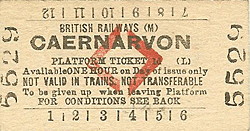 |
the building freely paying no heed to any humans who were working there. When the box closed a team was sent in to strip out all of the working parts. Once this was done the timber structure was doused with paraffin. A large gathering of railway personnel and locals came to watch what was to follow. Dogs had been brought to the scene to catch any rats that fled from the building. When a match was put to the box and it started to burn hundreds of rats came pouring out, and the dogs began to set upon them. Most of the rats escaped, causing problems for the townspeople.
From 7 December 1964 a DMU service operated between Bangor and Caernarvon with some longer-distance workings, as shown in the tables below. The trains mostly stopped at the former ‘up and down’ platform 3 but occasionally they used platform 2. On Saturdays during the summer months trains for Butlin’s ran to Caernarvon where passengers transferred to coaches for the onward journey to the camp. The service that operated from 14 June 1965 is shown in the table below. There was no Sunday service.
| Departures from 14 June 1965 |
Destination |
Arrivals from 14 June 1965 |
From |
| 07.00 |
Llandudno Junction |
08.49 |
Rhyl |
| 07.35 |
Bangor |
09.41 |
Bangor |
| 09.25 Saturdays Only |
Manchester Exchange |
10.04 Saturdays Only |
Manchester Exchange |
| 09.52 |
Llandudno Junction [On weekdays] Bangor [On Saturdays] |
10.31 Saturdays Excepted |
Rhyl |
| 11.20 Saturdays Only |
Manchester Exchange |
11.12 Saturdays Only |
Manchester Exchange |
| 11.45 |
Bangor |
11.29 Saturdays Excepted |
Liverpool Lime Street |
| 12.30 |
Bangor |
12.19 Saturdays Excepted |
Bangor |
| 13.39 |
Bangor |
13.44 Saturdays Only |
Liverpool Lime Street |
| 15.00 Saturdays Excepted |
Llandudno |
14.12 Saturdays Excepted |
Llandudno Junction |
| 15.10 Saturdays Only |
Liverpool Lime Street |
14.49 |
Bangor |
| 16.00 Saturdays Excepted |
Llandudno Junction |
16.19 Saturdays Only |
Llandudno Junction |
| 16.55 |
Llandudno Junction |
17.56 |
Bangor |
| 17.45 Saturdays Excepted |
Rhyl |
19.34 |
Bangor |
| 18.15 |
Bangor |
21.14 Saturdays Only |
Llandudno Junction |
| 20.15 |
Llandudno Junction |
|
|
| 21.20 Saturdays Only |
Llandudno Junction |
|
|
Butlins passengers did not appreciate having to transfer to coaches and in the following years many switched to road for the entire journey. In 1966 the line from Caernarvon to Menai Bridge was singled.
On 1 July 1969 Prince Charles was invested as Prince of Wales at Caernarfon and, as in 1911, special trains were run. Empty stock was stored on the remaining section of the Afon Wen line, but shortly after the investiture the line was lifted back to Caernarvon No. 2 box. On 4 August 1969 Caernarvon closed to goods services.
 |
Having been reprieved from possible closure in 1964 the Caernarvon branch was apparently secure as depicted on the Network for Development map of March 1967. However on 9 December 1968 it was proposed for closure, and the Minister of Transport agreed to this on 3 October 1969. Consequently on 5 January 1970 the passenger service was withdrawn, |
and the line to Menai Bridge closed completely.
Having been reprieved from possible closure in 1964 the Caernarvon branch was apparently secure as depicted on the Network for Development map of March 1967. However on 9 December 1968 it was proposed for closure, and the Minister of Transport agreed to this on 3 October 1969. Consequently on 5 January 1970 the passenger service was withdrawn, and the line to Menai Bridge closed completely.
Contracts had been let for the demolition of the station and goods yard, but on 23 May 1970 a fire on the Britannia Bridge isolated Holyhead from the railway network; Holyhead was, at that time, an important freightliner depot. Caernarvon was pressed back into use for freightliner services receiving its first trains on 15 June 1970. The station and goods yard were used for the loading and unloading of containers until 5 February 1972. The line then closed completely and was lifted shortly after.
The site remained derelict until the late 1970s when the station was demolished. In the late 1990s a supermarket was built on the station site.
Totem from Richard Furness, timetable from Chris Totty, tickets from Michael Stewart, Investiture ticket Ken Robinson, route map drawn by Alan Young
Sources:
To see the other
stations on the Menai Bridge - Afon Wen line click on the station
name: Menai Bridge, Treborth, Port Dinorwic (1st), Port Dinorwic (2nd), Griffiths Crossing , Carnarvon Pant, Dinas, Llanwnda, Groeslon, Penygroes, Pant Glass, Brynkir, Ynys, Llangybi, Chwilog & Afon Wen
See also stations on the Llanberis branch: Carnarvon Morfa, Pont Rug, Pontrhythallt, Cwm-y-glo, Padarn Halt & Llanberis
See also: Nantlle
See feature: Carnarvon Town Line
To see a selection of photos from the period when the station was in use as a temporary railhead following the Britannia Bridge fire click here
|

old6.jpg)
.jpg)

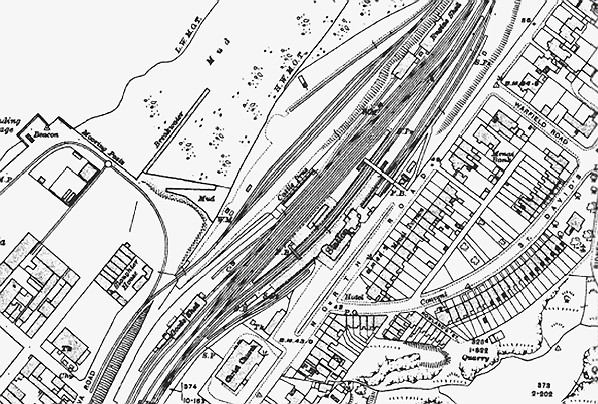
old4.jpg)
old3.jpg)
old10.jpg)
old16.jpg)
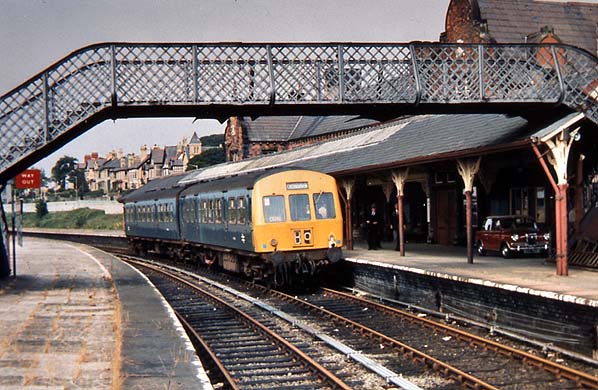
old2.jpg)
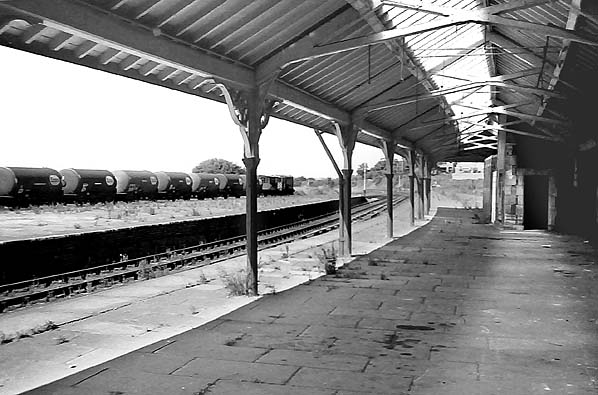
.jpg)
5.jpg)

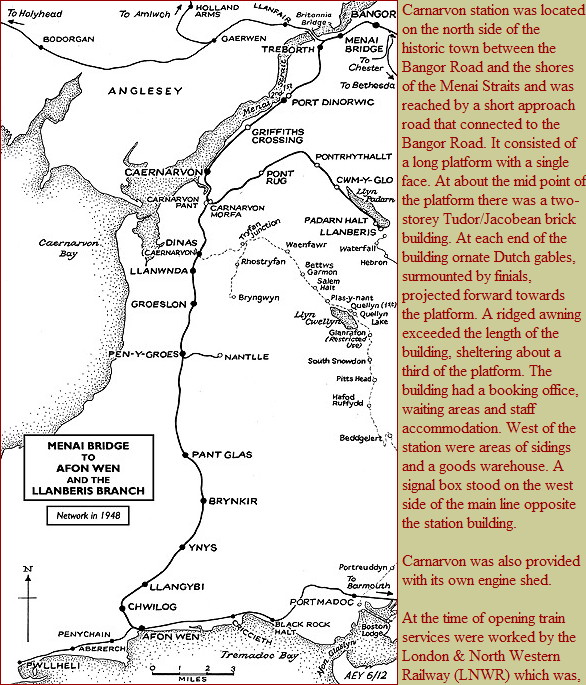


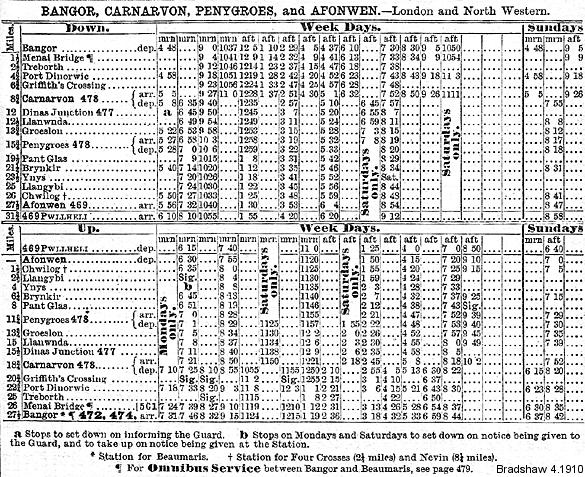





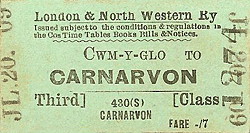
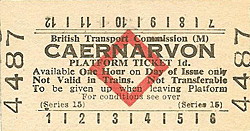
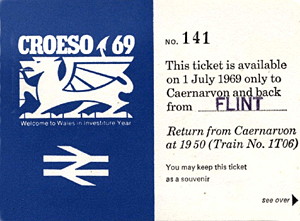
old8.jpg)

old5.jpg)
old12.jpg)
old14.jpg)
old17.jpg)
old11.jpg)
old1.jpg)
21.jpg)
18.jpg)
1.jpg)
.jpg)

 Home Page
Home Page